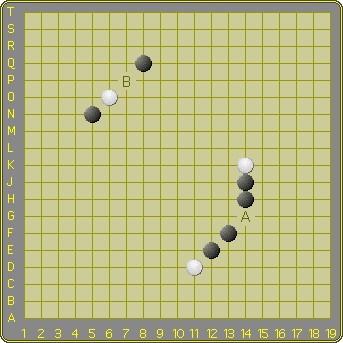Page 13 of 18
Pente
Five-in-a-row games are very old. In Japan they have been played on the 19x19 Go board for over a thousand years under the names Gobang and Gomoku. The rules were simple: players alternate to put a stone on a vacant point, and the first player to get an unbroken row of 5 stones, horizontally, vertically or diagonally, wins.
It has been proven that with the above 'free rules' the first player has a win.
In the year 1899 the Japanese players began to play more organized, so they changed the name for serious playing from Gomoku to Renju, five pearls, in a row. In Renju the first player is subject to a number of handicaps, to ensure balanced play. If you want to read more about Renju you are welcome to visit RenjuNet.
Pente, was introduced by Gary Gabrel from Stillwater, Oklahoma, USA at the end of the seventies and became very popular in the USA in the first half of eighties. The game adds an interesting twist to the general five-in-a-row idea: pairs of opponent's stones that are straight or diagonally adjacent can be captured in the 'custodian fashion', that is: by sandwiching them between two of one's own stones. The object is two-fold: either one creates a straight or diagonal line of 5, or one captures 5 pairs of stones.
It should be mentioned that the game of Pente strongly resembles the Japanese game of Ninuki-Renju, that had its own organization in Japan from 1923 till 1940, when combat progressed to a larger area.
In 1983 Gary Gabrel, then president of Pente Games, Inc. announced the sale of Pente to Parker Brothers Game Co.
The current copyright holders are Hasbro.com.
In 1984 Rollie Tesh, former Pente champion, suggested Keryo Pente, in which the capture of triplets is also allowed. This effectively prevents a well known defense in regular Pente: extending a threatened pair to make it a triplet. The alternative to a line of 5 is now 15 stones.
Pente served as the inspiration for Hexade.
Rules
The game starts on an empty board. Players take turns to put one stone. White begins.
 | Object The game is won by the first player who:
Capture Pairs of opponent's stones that are straight or diagonally adjacent can be captured in the 'custodian fashion', that is: by sandwiching them between two of one's own stones. As in othello, it is the act of sandwiching that brings the capture: black can make a double capture at A, white can play safely at B. In keryo pente triplets can be captured likewise. |
Applet
download applet play online a word on notation | You can download this MindSports applet, which is tailored to save games played in the Pit, offline. The Pente applet can be set to pente, keryo-pente, renju and ninuke-renju mode. |
External links
- Play live @ iG Game Center
- Mark's five-in-a-row games
- RenjuNet
- Pente.orgThis is a place to play Pente for free, chat live with other players, or play against a powerful computer opponent.
- Bill's Pente Program
- Pente @ Richard's PBeM Server (turnbased play)
- Keryo Pente @ Richard's PBeM Server (turnbased play)
Pente © Hasbro.com
Java applet © Ed van Zon
